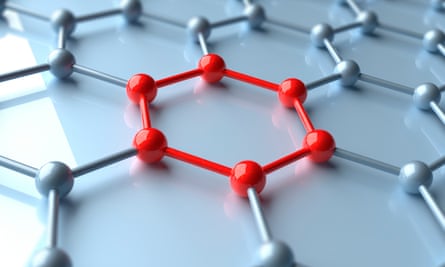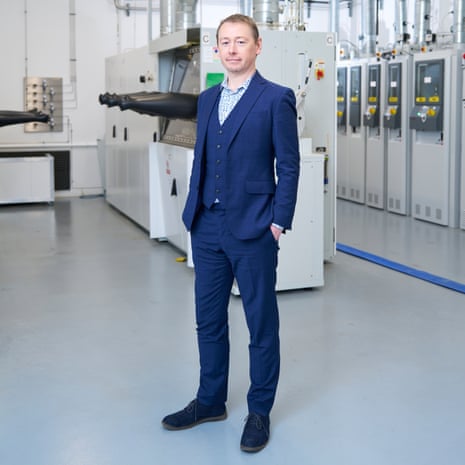The first thing visitors to Paragraf’s lab, in the Cambridgeshire village of Somersham, are shown is a thin disc made of synthetic sapphire with a piece of graphene taped on to it. This was the first graphene product the company made, and it quickly evolved to a small wafer of 64 tiny graphene devices arranged in a grid. These days, the company produces six-inch wafers that hold 9,000 chips.
Graphene, a 2D form of carbon, with the atoms arranged in a hexagonal structure, is mainly used to strengthen concrete and paints, but is now being touted as a replacement for silicon in semiconductors. China has started using it to get ahead in the global microchip wars.
The UK needs to do all it can to avoid losing out to China and the US in the race to crack the technology, says Simon Thomas. He founded Paragraf in 2017 with Prof Sir Colin Humphreys and technical director Ivor Guiney, who all worked together at Cambridge University, as a university spinout.
Graphene, hailed as a “super material”, is extracted from graphite, the crystalline form of carbon used to make pencils, and comes as a latticed sheet just one atom thick. Thomas believes it will “fundamentally change the world”, altering the way everything from mobile phones and computers to electric cars, healthcare and military equipment is manufactured.
Smartphones made using the material could be worn on your wrist, and graphene tablets could be rolled up like a newspaper, according to the University of Manchester, where, in 2004, graphene was first produced.
Thomas, wearing a blue suit with matching shoes and a flowered shirt, says: “Graphene and other 2D materials will change the status quo to provide technologies we have never ever seen before, and performance levels we have never ever seen before. In electronics it will have a huge effect on reducing energy consumption and creating faster semiconductors.”
Potential uses include quantum computing, magnetic sensors in a new generation of MRI scanners, and consumer technology such as delivery drones.
Graphene is one of the strongest and thinnest materials in existence, much tougher than steel but lighter than paper, harder than a diamond but more elastic than rubber. It is also highly effective at conducting heat and electricity.
Paragraf is among the first companies in the world to mass-produce graphene-based devices, including sensors for electric cars.
In its Somersham lab, two reactors – big boxes whose main part is shaped like a pizza oven – produce enough graphene to make 150,000 sensors a day. Paragraf uses the material in two ways: to measure magnetic fields, and to convert micro-organisms such as bacteria and viruses into electrical signals by combining graphene with a wet layer of chemistry as a biosensor.
Paragraf has thrown its weight behind biosensors, which can detect the difference between viral and bacterial infections to determine whether a person needs antibiotics. It can also reveal the presence of conditions such as Covid-19, or spot infectious diseases in plants or animals.
So as to expand its capacity in this area, Paragraf acquired a biosensor firm, San Diego’s Cardea Bio, in April. The devices will be manufactured at a new site a few miles away in Huntingdon.
Thomas worked on semiconductors and compound materials for German engineering company Aixtron for 11 years, including spells in Asia. When he returned to the UK in 2015, Humphreys asked whether they could work together, creating graphene on a larger scale.
Things could easily have been very different. Thomas has been interested in science since childhood, but he also loved drawing and painting. He considered doing a fine art degree, but a teacher advised against it, and he did aerospace engineering at Liverpool University instead.
Thomas calls his background “working class”: his father was a colour matcher in a factory, his mother a teaching assistant. “We didn’t have that much, but at the back of the dictionary they had was a periodic table,” recalls Thomas. He knew most of the table of chemical elements by heart by the age of six.

At Liverpool, Thomas went on to do a doctorate in material engineering.
More than a decade later, he joined Humphreys’ research team at Cambridge University, and later they set up Paragraf: the name is short for Paradigm Graphene.
The firm has attracted about £70m of funding so far, and plans to list on the stock market in the next four or five years. “I would absolutely love to grow a manufacturing company here, grow it into a profitable business, and list in the UK,” Thomas says, though he does not rule out a Nasdaq listing.
Investors include the UK Treasury and In-Q-Tel, a venture capital firm linked to the CIA, which will help Paragraf expand in the US. Among its early backers was Hermann Hauser, who helped set up the Cambridge chip designer Arm. His investment firm Amadeus Capital Partners holds a 6.7% stake in Paragraf.
Paragraf made a pre-tax loss of £11m in 2022, after a £6.4m loss the year before, as an increase in staffing and materials costs outweighed a near sevenfold rise in revenues to almost £230,000.
Such growth has attracted takeover interest from China, but Thomas and the board rebuffed the approaches, which would have required moving to the country. “It was a very attractive offer,” he says. “The problem with taking money from China is that it doesn’t come without government interference.”
China has tried to corner the market in graphene. An estimated 5,000 companies are now working on graphene products there, says Ron Mertens, owner of the website Graphene-Info.
Chinese manufacturer Huawei uses graphene in its Pocket S clamshell phone, and Apple is reportedly testing graphene films for the iPhone 16, to avoid overheating.
A few months ago, China even declared that it would mass-produce microchips by using graphene instead of silicon, making a full transition by 2025, though the claim was met with scepticism in the west.
Thomas is encouraged by the Asian country’s ambition: “They have seen the light already. They have seen the fact that this material is going to be a big future material, and they are committed.”
However, many graphene companies are struggling to generate revenues and raise funding, and some have gone under. One of the first specialists, Applied Graphene Materials in Durham, sold its main business to a Canadian firm and wound up the rest. Versarien in Gloucestershire has scaled down its research team to cut costs.
In May, the government announced a £1bn investment in the UK semiconductor industry over the next decade, a sum dwarfed by the $52bn being spent by the US.
“If we want to be at the cutting edge, we have to have the support,” Thomas says. “Cash is always good, but it means commitments from the government to help us flourish in the UK. Commitments in how they will help us get talent, how they will help us put infrastructure in, and how they will help us trade with other countries.”
CV
Age 46
Family Single.
Education MEng in aerospace engineering, and PhD in materials science and engineering, at Liverpool University.
Last holiday Tenerife.
Best advice he’s been given “Always stand up for what is right and what you believe in, even if you stand on your own.”
Biggest career mistake “Becoming too comfortable in a job and realising way too late that I should have moved on many years before.”
Word he overuses “Integratable – not even a real word but so important to getting new materials into the semiconductor world.”
How he relaxes “When possible, running and sleeping.”
